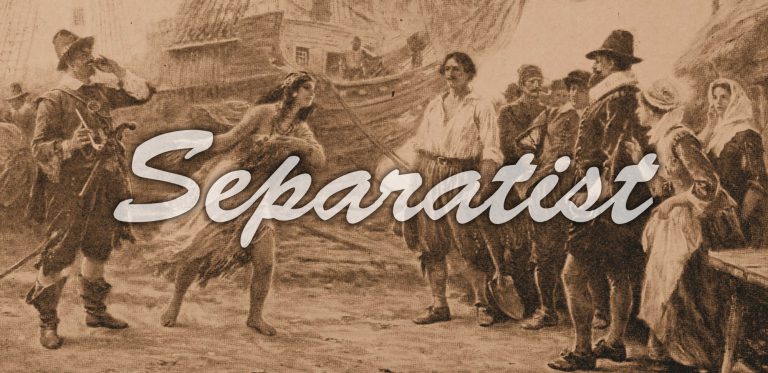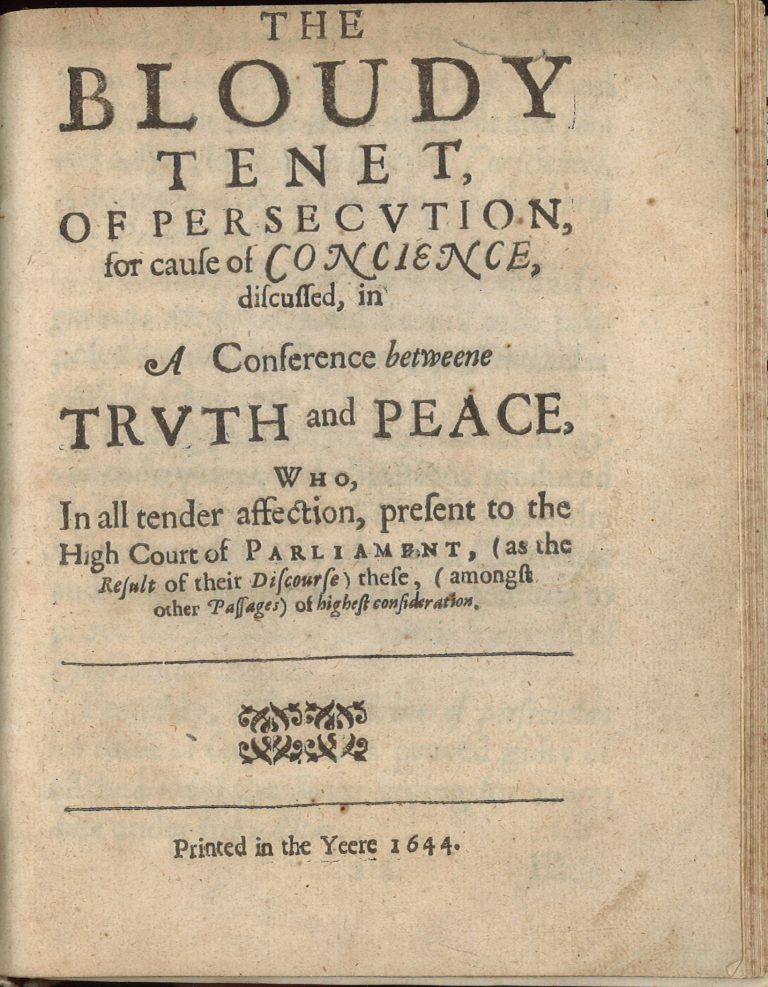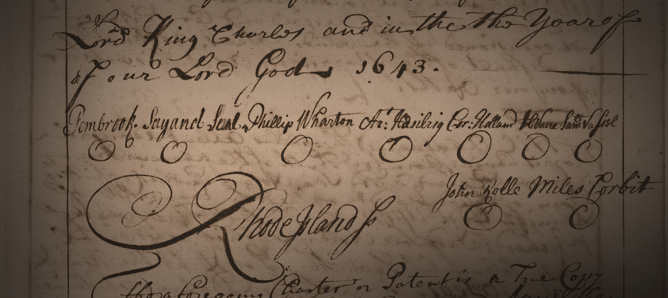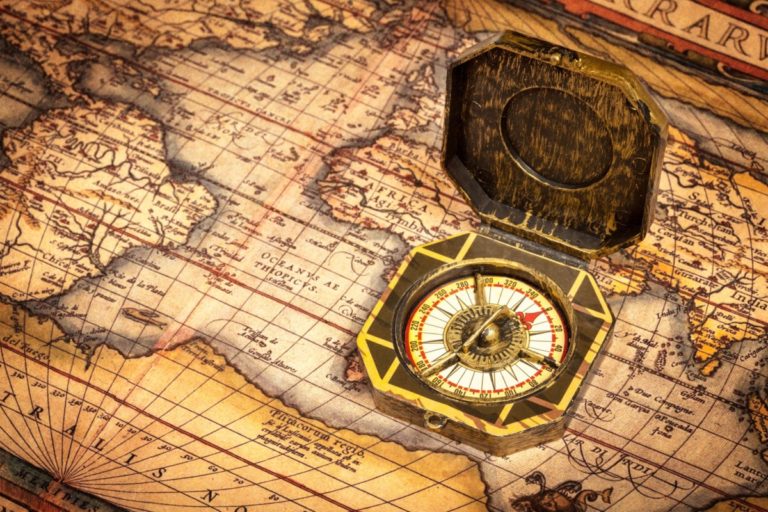Read, Search, Print, or Download PDF…
Read the 1894 G.B. Thayer Book. See below for family history clips.
Relevant Book Notes
Personal family history research by Mike Prestwood. Italics text is directly from the book. I’m lucky in that this book has information on 30+ direct-line ancestors from the 1500s and 1600s as well as many aunts, uncles, and cousins. The following information is focused on my direct-line ancestors which is important to me for validating family history data. If the direct-line data is correct, filling in aunts, uncles, and cousins is much easier with little risk of having to delete whole lines of ancestors. Something I’ve had to do many times and wish to avoid.

Before Preface: Family History Chart
This chart is from the 1894 G.B. Thayer Book. Highlighted in blue are my ancestors clearly indicating the daughter of Roger Williams married John Sayles.
The following chart is from the book. Highlighted in blue are my ancestors clearly indicating the daughter of Roger Williams married John Sayles–a key genealogical data point for my family.
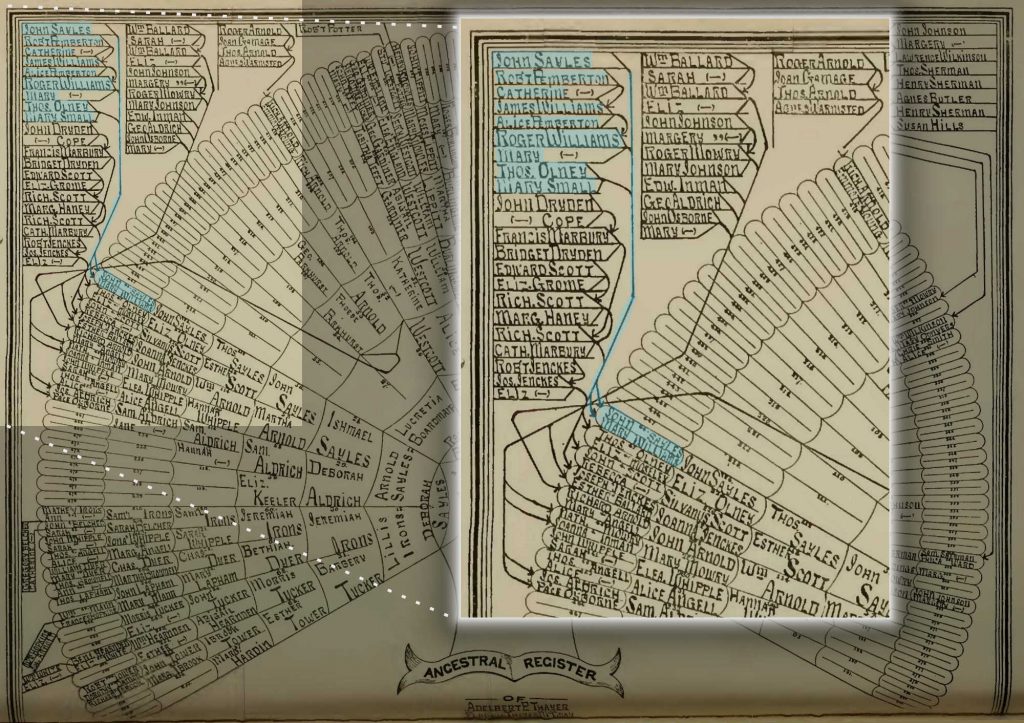
Burlingame
Page 29 documents the people in green in the following chart I created from my database:

My relation to Isabella Baxter
For reference, here is my link to Isabella Baxter.
Regarding Roger Burlingame (1620-1718)
My 10th great-grandpa.
Roger moves from Connecticut to Warwick, Rhode Island:
Roger Burlingame came from Stonington, Conn., to Warwick, R. I., in 1660, having lived at Stonington at least since 1654.
Roger moves to Providence:
In 1671 he removed to Providence, and continued to live there,
Won Warwick Deputy Election from Providence:
although elected a deputy in 1690 from the town of Warwick. This election was declared illegal, ”after much debate in the assembly,” and it was ordered that “he is not accepted.”
Death and a little info on wife Mary:
He died at Providence, September 1, 1718. His wife, Mary ( ), died about the same time.
Regarding Thomas Burlingame Sr. (1667-1758)
My 9th great-grandpa.
Birth and marriage:
Thomas Burlingame, son of Roger and Mary ( ) Burlingame, was born at Warwick, R. I., February 6, 1667, and married Martha Lippitt, daughter of Moses and Mary (Knowles) Lippitt, of Warwick, about 1687.
Died in Cranston:
After living at Providence for a time he settled at Cranston, where he died July 9, 1758.
Jenkes
Pages 59-61 documents the people in green in the following chart I created from my database. Also spelled Jenks, Jynks, etc. This book covers my 9th and 10th direct-line ancestors as well as Joanna Jenckes the sister to my direct-line ancestor Judge William T Jenkes.

Regarding Joseph Jenkes Sr. (1599-1683)
My 10th great-grandpa.
Birth. In dispute. I currently use the date of 1599.
Joseph Jenckes, the builder of the first fire engine used in Boston and, probably, in America, was born in 1602, at Hammersmith, or Hounslow, or at Colnbrook, in the edge of Bucks, near London.
History back to Robert Jenks in 1350:
The names of his ancestors have been traced back through ten generations to Robert Jenks, of Wolverton (Manor), in the parish of Eaton-under-Eywood, Shropeshire, to the reign of Edward III., in 1350. Robert was the son of Jenkyn Cansbrey, of Wolverton, and of Dorothy, daughter and coheiress of Sir Walter Collyng, Knight of Church Stretton, in the same county.
History from 1350 back in time. Records are available!
From Robert the ancestry is traceable as far back as Welch annals and bardic pedigree are carried in the house of Elystan Glodrydd.
Immigration to Massachusetts Bay Colony:
Joseph Jenckes came to this country with his son, Joseph, early in the settlement of the Massachusetts colony, and in 1645 had settled at Lynn.
Widower by 1645:
He was then a widower.
Occupation:
He was by trade a blacksmith, and was one of the workmen whom John Winthrop, the younger, engaged and brought over with him in order to start the iron foundry at Lynn. In 1646, June 10, he was granted ” liberty to make experience of his ability and inventions for ye making of engines for mills to go with water for the more speedy despatch of work than formerly and mills for the making of scythes and edge tools with a new invented saw mill, that things may be afforded cheaper than formerly.” This petition was granted for fourteen years ” without disturbance by any other setting up like inventions that so his study and costs may not be in vain or lost.”
Inventor, first coin dies:
He soon became known as the “patentee,” his patents being among the earliest taken out in the country. He made the dies for coining the first money used in the colony, was the first founder who worked in brass and iron, and by his hands the first models were made and the first castings taken of many domestic implements and iron tools. The first article said to have been cast was a small iron pot, since in possession of the late Alonzo Lewis, historian of Lynn.
First fire engine in Boston, maybe in America!
That he built the first fire engines used in Boston is seen from the extract: ” Boston Town Records—12th, 1, 1653-4. At a meeting this day * * * the selectmen have power and liberty to agree with Joseph Jynks for Ingins to Carry water in Case of fire if they see Cause soe to doe.”
Admonished for missing church:
In 1666, November 29, he was admonished by the court for not attending public worship.
Second marriage to Elizabeth, move to Providence:
His second wife was Elizabeth ( ), whom he married at Lynn, in 1646. She died in July, 1679, at Providence, R I., to which place they had removed late in life, first stopping at Warwick for a time.
Death:
He died in March, 1683, at Providence.
Regarding Joseph Jenkes Jr. (1628-1716)
My 9th great grandpa.
Birth. In dispute. I currently use 1628.
Joseph Jenckes, son of Joseph Jenckes, was born near London, England, in 1632.
Father immigrated, left his son Joseph. Mom Joan died by this time. Joseph left with Joan’s parents.
When his father came to this country, in 1643, the lad was left by him with his maternal grandparents, his own mother being dead. His father assigned a sum of money sufficient for his maintenance till he should become of age, when he was to join his father in America.
Son immigrated to join father about 1648. If we can prove immigration year, we can settle birth year!
He crossed the seas, however, at the age of 16, and came to his father at Lynn, Mass.,
Marriage:
where he married Esther Ballard, daughter of William and Elizabeth ( ) Ballard.
Accused of treason:
In 1661, in May, he was accused before the General Court of high misdemeanors in divers treasonable words against the King’s majesty. He was acquitted, however.
Moved to Warwick, built saw mill:
In 1669 he removed to Warwick, R.I., where he built a saw mill on the Pawtuxet river, agreeing, when he purchased the privilege from the owners, to let them have boards at 4 shillings 6 pence ” the hundred,” and all other “sawn work” at the same rate.
Other work and actions:
In January, 1670, he served as foreman of a jury in the case of a man and wife “who were both drowned in the river of Pawtuxet the 16th at night.” In 1671 he built a forge and saw mill at Pawtucket Falls, which was destroyed by fire five years later by the Indians in the King Philip war. In 1680 he and two others were empowered to purchase a bell for the use of the colony to give notice of the sittings of the Assembly, Courts of Trial and General Council. Earlier the members of the Assembly were called together by beat of drum. In January, 1690, he and five others wrote to William and Mary, among other things, congratulating them upon their accession to the throne. He was three times chosen deputy and served as assistant thirteen years.
Death:
He died at Providence, January 4, 1717.
Knowles
Page 66 documents the Knowles in green below in the following chart I created from my database.
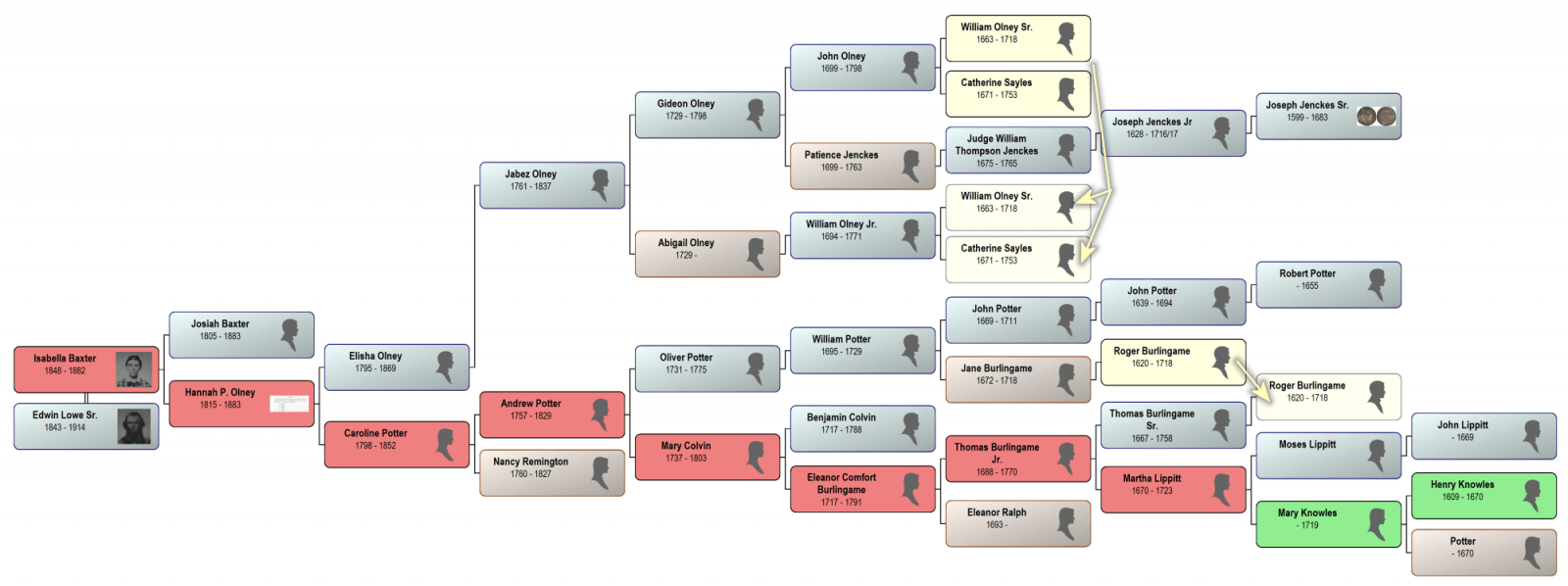
Regarding Henry Knowles (1609-1670)
My 11th great grandpa.
Born:
Henry Knowles, one of the early settlers of Portsmouth, R. I., was born in England, January 6, 1609,
Move to Portsmouth:
and, after living at Portsmouth till 1655, he moved to Warwick.
Time in Portsmouth:
In 1657, an action of trespass was there brought against him. In Portsmouth, he had also been ordered ” to cut his lot shorter.” In 1664, with three others, he was authorized by the town ” to keep Ordinaries for the entertainment of strangers ” during the session of the King’s Court at Warwick. In 1666, he, with other members of a coroner’s jury, found the following somewhat ambiguous verdict:
“We, who are engaged to see this dead Indian, do find, by diligent search, that he was beaten, which was the cause of his death.”
Death and a little info on wife:
Henry Knowles died at Kings Town, in January, 1670. His wife, who was the daughter of Robert Potter, of Portsmouth, survived him.
Regarding Mary Knowles (___-1719) and Moses Lippitt (–)
Mt 10th great grandpa.
Born, came to Warwick with father:
Mary Knowles, daughter of Henry and ( ) Knowles, was born at Portsmouth, R. I., and came to Warwick with her father in 1655.
Marriage:
She married Moses Lippitt, son of John and ( ) Lippitt, of Warwick, November 19, 1668, and died at Warwick, December 28, 1719.
Descent. Mary Knowles married Moses Lippitt;
Daughter Martha married Thomas Burlingame, my 9th great grandparents.
daughter, Martha Lippitt, married Thomas Burlingame;
Lippitt
Page 70 documents the Lippitts in green below in the following chart I created from my database.

Regarding John Lippitt (___-aft 1669)
My 11th great grandpa.
Immigration to Providence:
John Lippitt, one of the early settlers at Providence, R. I., came from England as early as 1638, in which year he had a lot and six acres of land at Providence.
Helped form government under new charter.
In 1647 he was chosen one of the commissioners to meet at Portsmouth to form a government under the charter.
Moved to Warwick:
In 1648 he had removed to Warwick, where he was living as late as 1669. He probably died soon after. Nothing is known of his wife.
Regarding Moses Lippitt ()
My 10th great grandpa.
Moses Lippitt, son of John and ( ) Lippitt, was born at Providence, R. I., or possibly at Warwick, where, November 19, 1668, he married Mary Knowles, daughter of Henry and ( ) Knowles, of Warwick. He was, by trade, a tanner. He was five times appointed deputy from 1681 to 1699, was overseer of the poor in 1687, and when he died, January 6, 1703, at Warwick, he left an estate valued at ^”456, including stock of leather, green hides and bark, tanning instruments, book debts valued at ,£100, etc. The Lippitt burial ground, in which are still to be found the uninscribed graves of Moses, and doubtless his father as well, is situated in a pasture southeast of the road and a quarter of a mile east of the Quaker meeting house at Old Warwick.
Regarding Martha Lippitt (1670-1723)
My 9th great grandma.
Born:
Martha Lippitt, daughter of Moses and Mary (Knowles) Lippitt, was born at Warwick, R. I., about 1670,
Marriage:
and married Thomas Burlingame, of Providence, son of Roger and Mary ( ) Burlingame, about 1687.-
Death
They settled at Cranston, where she died in 1723.
Olney
Pages 86-88 documents the Olney relatives in green below in the following chart I created from my database.

Regarding Thomas Olney (1600-1682)
My 10th great grandpa. Corrected below with a strike through for bad data and green bold for correct data. Mary “Small” was this Thomas Olney’s mom.
Regarding birth and immigration:
Thomas Olney, one of the Baptists notified to depart from Massachusetts or appear at the next court, was born at St. Albans, Hertford County, England, in 1600, and came to this country in the ship, ” Planter,” from London, in 1635.
Marriage to Marry Ashton:
Several years before his departure he married Mary Small Ashton, of St. Albans, who, besides two sons, came to America with him.
Occupation and time at Salem:
He was a shoemaker by trade, and settled at Salem, Mass.
Banishment from Salem, MA,
In 1638, he and several others were licensed to depart from Mass. Not going immediately they were ordered ” to appear at the next court (if they be not gone before) to answer such things as shall be objected.” They went. In October of the same year he had settled at Providence, where he was one of the twelve original members of the First Baptist Church, organized in 1639. His former pastor at Salem, in explaining in a letter to a brother pastor the cause of Thomas Olney’s expulsion from Salem, wrote: ” He wholly refused to hear the church, denying it and all the churches in the Bay to be true churches. The great censure of this, our church, was passed upon him.”
Time at Providence:
At Providence he was twice chosen treasurer of the town, was six times appointed commissioner, was nine times chosen assistant, four times deputy, and was for eight years a member of the town council. His homestead was south of the present state house, Arsenal Lane now running through it. In 1643 he bought land and settled at Warwick. In 1656 he was chosen judge to try cases where the amount involved did not exceed forty shillings.
Surveyor:
Thomas Olney was a first-class surveyor, and it is said that as he entered upon the surrounding lands with his field book, chain and compass, and mystic words, with the peculiar dignity of official characters of that day, he may well have inspired the Indians with profound awe and led them to feel that no Indian could henceforth dwell upon that part of their tribal property again.
Death:
He died at Providence in 1682.
Comment on the area:
During the early settlement of New England it was claimed in Connecticut that if a man was too bad to live with in Massachusetts, they sent him to Rhode Island, and when they found one a little too good, they sent him to Connecticut, while the remainder of tolerable and average orthodoxy and respectability were allowed to remain undisturbed.
Regarding Thomas Olney (1632-1722)
My 9th great grandpa. In this passage, the book has a few mistakes. Corrected below with a strike through for bad data and green bold for correct data.
Birth, parents, and immigration:
Thomas Olney, son of Thomas and Mary Small Ashton Olney, and a prominent Baptist clergyman at Providence, R. I., was born at St. Albans, Hertford County, England, in 1632, and came to this country with his father, in the ship, ” Planter,” from London, in 1635.
From Salem to Providence and marriage to Elizabeth Marsh:
From Salem, Mass., in 1638, he came to Providence, where, July 3, 1660, he married Elizabeth Moseley Marsh.
Armed protest:
In 1655, five years before, at the age of twenty-three, he was implicated in a religious tumult, or more strictly, under the pretense of holding a training, he, with others, engaged in an armed resistance to authority. No serious results followed.
Pastor:
In 1668, at the age of thirty-six, he was ordained pastor of the First Baptist Church. In a controversy a few years later, with George Fox, the Quaker, the Rev. Thomas Olney is said to have answered Fox in an article, entitled ” Ambition Anatomized,” with ” unseemly severity.”
Occupations:
He held many public offices. For thirty-seven years he was town clerk; for thirty years, a member of the town council; for fourteen years, a deputy, and for six years, assistant. He was also ” proprietor’s surveyor.” In 1698 he was appointed on a committee “to meet the Connecticut gentlemen to treat before Lord Bellemont about the western bounds of the colony.” In 1699 he was chosen “agent for the colony to go to England for maintaining of liberties granted in our charter.” This appointment he declined.
Death:
He died at Providence, June 11, 1722. The inventory of his estate included ” fifty-five bound books and twenty-three small unbound books.” His wife died about the same time and place. His homestead was near the present location of the American Screw Co.’s works, at the foot of Stampers Hill, and he also owned large tracts of land in North Providence and Lincoln.
Pemberton
Page 91 documents the relatives in green below in the following chart I created from my database.

Regarding Robert Pemberton (1523-1578), and Catherine Stokes (1531-1628)
My 12th great grandpa and Roger Williams’ maternal grandpa.
Robert Pemberton, maternal grandfather of Roger Williams, and his wife, Catherine ( ), were residents of St. Albans, Hertfordshire, England, where they died the latter part of the 16th century.
Regarding Alice Pemberton (1564-1634)
My 11th great grandma, and Roger Williams’ mom.
Birth:
Alice Pemberton, mother of Roger Williams and daughter of Robert and Catherine ( ) Pemberton, was born at St. Albans, Hertfordshire, England, in 1564.
Marriage:
About 1590, she married James Williams, of St. Albans,
Move to London:
and not long after they moved to London,
Death, I’m currently using 1 Aug 1634 as that is in other documents. The daughter listed here refers to Mary, Roger’s first born, born the year before and my 9th great grandma.
where she died in January, 1634. In her will she left ^”10 yearly, for twenty years, to her son, Roger, “now beyond the seas;” or, in case of his death, to his wife and daughter. She provided for the distribution of bread to the poor on the day of her funeral and left money for a supper for her tenants.
Potter
Pages 94-95 document Robert Potter, his wife, their daughter, and her husband Henry Knowles. They are highlighted in green below in the following chart I created from my database.

Regarding Robert Potter () and wife (___-1643)
My 12th great grandparents.
Death of wife following the 1643 Massachusetts Bay Colony attack on Warwick. In 1643, the Massachusetts Bay Colony and Warwick had a conflict. Warwick wanted to have religious freedom, so the Massachusetts Bay Colony persecuted them just like what the Church of England did to them. Hypocrites. Conservative religious wackos are usually hypocrites. No exception here. In 1643, the Massachusetts Bay Colony troops attacked Warwick, burned it down, and captured Samuel Gorton and others. They tried them for heresy and sedition, sentenced Samuel Gorton to death, but the majority of deputies refused to sanction the penalty. The wives and children were left to fend for themselves with no shelter. Several died including Robert Potter’s wife.
Robert Potter, the death of whose wife was afterwards caused by the exposure and hardships suffered at Warwick, R. I., when that place was besieged by the Massachusetts troops,
Immigration to Boston:
came to this country from Coventry, England, in 1630, and first settled on Boston street at Lynn, Mass.
A farmer and freeman:
He was a farmer by occupation and was soon admitted freeman.
Move to Roxbury:
In 1634 he had removed to Roxbury.
Banished from Massachusetts Bay Colony:
His presence in Massachusetts was not, however, to be tolerated for any length of time, and, in May, 1638, he was warned by the General Court to remove out of the colony. He went that year.
Move to Aquidneck, Rhode Island–an island within Rhode Island.
He was admitted as an inhabitant of the island of Aquidneck, R. I., that fall, and the next spring, with twenty-eight others, signed the civil compact.
Time at Aquidneck:
In 1640, however, friction arose, and the General Court passed a vote that ” if he come upon the island armed he shall, by the constable (calling to him sufficient aid) be disarmed and carried before the magistrate and there find surety for his good behavior.”
Move to Warwick with Samuel Gorton:
In 1642, he sold his house and land at Portsmouth, and settled, with Samuel Gorton and several others, at Warwick.
Massachusetts Bay Colony troops attack Warwick in 1643:
In 1643, in September, he and others were summoned to Boston to answer some complaints made by Indian chiefs. The Warwick men claimed they were outside the jurisdiction of Massachusetts, and refused to answer the summons. Soldiers from Boston were accordingly sent and besieged the inhabitants of Warwick in a fortified house. The charge of holding “blasphemous errors,” of which they must repent, was then made against them. The house was finally captured and the men taken to Boston for trial.
The women and children were driven into the woods and their homes burned behind them. The hardships suffered resulted in the death of three of the women at least, one of whom was the wife of Robert Potter.
Trial of Samuel Gorton with others including Robert Potter:
He was brought before court in November, charged with heresy and sedition, and was sentenced to prison during the pleasure of the court. In addition he was charged not to speak against the church or state, or preach his heresies or break jail, or, on conviction, he should die.
He was sent to Rowley and kept in confinement, “wearing such bolts or irons as may hinder his escape,” till the next March, when he was banished, both from Massachusetts and Warwick.
He returned to Warwick, however, and was not again disturbed.
Time in Warwick:
In 1649, he was licensed to keep an inn,
and in 1651 was appointed commissioner.
In 1655, he was again appointed to keep a house of entertainment, and a convenient sign was to be set out at the most perspicuous place to give notice to strangers.
Death and descendents:
He died that year.
Bishop Alonzo Potter, of Pennsylvania, Bishop Horatio Potter, Bishop Henry C. Potter and Hon. Clarkson N. Potter, all of New York, are lineal descendants of Robert Potter.
Regarding ____ Potter, the daughter who married Henry Knowles
My 11th great grandma and grandpa. This book does not list her name, but does list her husband, their child Mary Knowles who married Moses Lippitt (my 10th gr-grandparents), and their daughter Martha Lippitt who married Thomas Burlingame (my 9th gr-grandparents), and other cousins descending to the author of the book.
Birth and immigration:
____ Potter, daughter of Robert and ___ _____ Potter, was born in England, and came to this country with her father in 1630.
Home burned down by the Massachusetts Bay Colony troops when they attacked Warwick in 1643. Her mom died from the following hardship.
Here is the book reference regarding my 11th great grandparents.
When Warwick was sacked by the Massachusetts troops in 1643, she was driven into the woods with many others, and her home was reduced to ashes.
Marriage:
She married Henry Knowles, of Warwick,
Death note:
and died in 1670, or after.
Descent line in book. In bold are my direct-line ancestors. Uncle Persis Burlingame is the brother of my ancestor Eleanor Comfort Burlingame (1717-1791), my 7th great grandma.
Descent. ____ Potter married Henry Knowles;
whose daughter, Mary Knowles, married Moses Lippitt;
whose daughter, Martha Lippitt, married Thomas Burlingame;
whose daughter, Persis Burlingame, married William Burton;
whose son, Benjamin Burton, married Alice Westcott;
whose son, Edmond Burton, married Lucretia Boardman;
whose son, Raymond Burton, married Deborah Sayles;
whose daughter, Adaline Burton, married John W. Thayer.
Sayles
Pages 97-98 list John Sayles Sr, and Jr. They are highlighted in green below in the following chart I created from my database. However, this book does NOT list Catherine Sayles as a daughter of John Sayles Jr (1633-1681) and Mary Williams (1633-1681). It also does not “list” their children at all except for John Sayles III and his descendents. It includes a passage only for their direct-line ancestor John Sayles III (my uncle), but none of the other children.

Regarding John Sayles Sr. (___-___)
My 10th great grandpa.
John Sayles, the progenitor of a noteworthy Rhode Island family, was born in Manchester, England, in 15—, and came to this country in 1635, in his own vessel, with his wife, two sons and several daughters. They first settled at Portsmouth, R. I.
Regarding John Sayles Jr. (1633-1681)
My 9th great grandpa.
Immigration, Portsmouth, Marriage to Mary Williams:
John Sayles, son of John Sayles, of Manchester, England, was brought to this country, by his father, in 1635, at the age of two years, and, after living for a time at Portsmouth, R. I., he came to Providence, where, about 1650, he married Mary Williams, daughter of Roger and Mary ( ) Williams, of Providence.
1653:
In 1653 he was treasurer of the Assembly which met at Providence, May 16.
1656:
In 1656 he ” entered an anker of liquor.” The same year he assisted Thomas Angell in rescuing a prisoner from the custody of a Massachusetts officer.
1657:
In 1657 he was empowered ” to treat with the Indians that lay claim to the meadows of Lohusqussuck, and clear it for the town and the above mentioned be accommodated therein.”
1677
In 1677 he was fined twenty shillings for not attending grand jury.
1650-1681, Various Occupations:
During the thirty years or thereabouts, from the time of his marriage till his death, he was at different times commissioner, town clerk, town treasurer, warden, grand juror, a member of the town council, and he was twelve times chosen assistant or deputy.
Death:
He died in 1681, and his grave with that of his wife and son-in-law, William Greene, can be found in the Easton burial ground, near Sachuset Beach, Middletown, R. I.
Williams
Page 143-145 the people highlighted in green below in the following chart I created from my database.

Regarding James Williams (1562-1621) and Alice Pemberton (1564-1634)
The parents of Roger Williams and my 11th great grandparents.
James Williams, father of Roger Williams, the founder of Rhode Island, was a merchant tailor in London, England.
He was probably born at St. Albans, Hertfordshire, where, about 1590, he married Alice Pemberton, daughter of Robert and Catherine ( ) Pemberton, of St. Albans, and soon after moved to and went into business at London He died in November, 1621, leaving his property to his wife and children, among others, mentioning his son, Roger. He also made provisions for the distribution of money and bread among the poor of St. Sepulchres, without Newgate, on the day or day following his funeral.
Regarding Roger Williams (1602-1683) and Mary Bernard (1609-1676)
My 10th great grandparents.
Birth, but most historians now believe Roger Williams was born in Smithfield part of Greater London. R.W.’s year is in debate and documented from 1599-1607. My best guess so far is 1602 which is what I use in my records.
Roger Williams, founder of the Rhode Island colony, was the son of James and Alice (Pemberton) Williams, of London, England. He was born possibly at St. Albans, Hertfordshire, about 1599, where his parents lived for a short time after their marriage and before going to London.
Schooling. Sir Edward Coke sponsored R.W. Shorthand had just been introduced and over the years R.W. developed his own shorthand.
He was elected scholar and was sent to Sutton’s Hospital, in 1621, by Sir Edward Coke, who took a liking to him from seeing him take sermons and speeches in the Star Chamber in shorthand. In 1625 he entered Pembroke College, Cambridge, and in 1627 took the degree of Bachelor of Arts.
Church of England Chaplain:
In 1629 he was chaplain to Sir William Masham, of Otes, in the parish of High Laver, in Essex County.
To America:
In 1630, December 1, he embarked at Bristol in the ship, “Lion,” and arrived at Boston, Mass., February 5, 1631.
Pastor in America, the info here is a bit wrong. He was assistant pastor until 1634. He did move from Boston, to Salem, to Plymouth, then back to Salem.
In a few weeks he was settled as pastor over the church at Salem, spending a part of the following summer, however, at Plymouth.
In 1634, Roger Williams moved to Salem and was the assistant to Pastor Samuel Skelton (1592-1634). Only after Pastor Skelton died, did Roger become the Pastor, or teacher. He was now empowered and got in trouble because of his beliefs.
In 1635. in the spring, he was summoned from Salem before the court at Boston for some offense in his preaching, and the following October he was banished from the colony. In January, 1636, the order of the court not having been obeyed, a messenger was sent to Salem to arrest him, when it was found he had fled three days before.
Some info on Roger Williams. Most of which is fairly accurate.
In writing of his experience at that time, he said: “I was sorely tossed for one fourteen weeks in a bitter winter season, not knowing what bed and bread did mean.” First seeking a settlement within the limits of the Plymouth colony, on Seekonk river, he was warned away, and finally came by water, with five companions in canoes, to the present site of Providence, R. I. This same year his mediations, at the request of Massachusetts, prevented a coalition of the Pequots with the Narragansetts and Mohegans. In writing of this service, years after, he said: ”Three days and nights my business forced me to lodge and mix with the bloody Pequot ambassadors, whose hands and arms methought reeked with the blood of my countrymen murdered and massacred by them on Connecticut river.” His interest in the colony and the important part he took in its affairs during the next half century, nearly, need not here be retold. These particulars are easily accessible in most public libraries.
Death:
In 1GS”2, when he was past four-score, he wrote: “I am old and weak and bruised (with rupture and colic), and lameness on both feet.” He died in the spring of 1683, and was buried on his own land, northeast of the junction of Benefit and Bowen streets, Providence.
Grave dug up 100 years later.
In digging a grave near his about 100 years after his death, a sexton obtained a view of his bones, which were then covered over completely with a long mossy substance. In 1800 a systematic effort was made to locate his grave, and, upon being successful, the party of investigators proceeded to make careful preparations toward removing his remains. Upon digging down to the known location of the head of the coffin the root of an adjacent apple tree was discovered. This tree had pushed downwards one of its main roots in a sloping direction and in nearly a straight course towards the precise spot that had been occupied by the skull of Roger Williams. There making a turn conforming with the circumference of the skull the root followed the direction of the back bone to the hips, where it divided into two branches, each one following a leg bone to the heel, where they both turned upwards to the extremities of the toes of the skeleton. One of the roots formed a slight crook at the part occupied by the knee joint, thus producing an increased resemblance to the outline of the skeleton of Roger Williams. This root has been preserved, and was seen by the writer in 1894 in the museum at Brown University.
His wife is buried next to him.
By the side of the grave of Roger Williams was another, supposed to be that of his wife, Mary. In this grave, wonderfully preserved, was found a lock of braided hair, the sole remaining human relic found in either grave, all else having completely disappeared. The wife of Roger Williams is said to have been Mary P Warnard. A possible clue to her identity is found in a letter of his written May 2, 1629, while he was chaplain to Sir AVilliam Masham, of Otes. Sir William had married a daughter of Sir Francis Barrington, and in writing to Lady Joan Barrington, after the death of Sir Francis, Roger expressed his affection for her niece.
Regarding Mary Williams (1633-1681) and John Sayles Jr (1631-1681)
My 9th great grandparents. In the book I have, the “W” in “Warnard” is crossed off and replaced with a “B”. I currently believe this is Mary Bernard.
Birth:
Mary Williams, daughter of Roger and Mary ( [B] Warnard) Williams, was born at Salem, Mass., in August, 1633,
Marriage:
and about 1650 married John Sayles, of Providence, R. I., son of John Sayles, formerly of Manchester, England.
Death:
They lived at Providence, where she died in 1681.
Burial:
She was buried with her husband in the Easton burial ground, Middletown, near Sachuset Beach.
Here is the included descendent line to the author in the Thayer book. Mary and John’s son John Sayles III is the brother to my direct-line ancestor Catherine Sayles.
…Mary Williams married John Sayles;
whose son, John Sayles, married Elizabeth Olney;
whose son, Thomas Sayles, married Esther Scott;
whose son, John Sayles, married Martha Arnold;
whose son, Ishmael Sayles, married Deborah Aldrich;
whose son, Arnold Sayles, married Lillis Irons;
whose daughter, Deborah Sayles, married Raymond Burton;
whose daughter, Adaline Barton, Sayles, married John W. Thayer.













